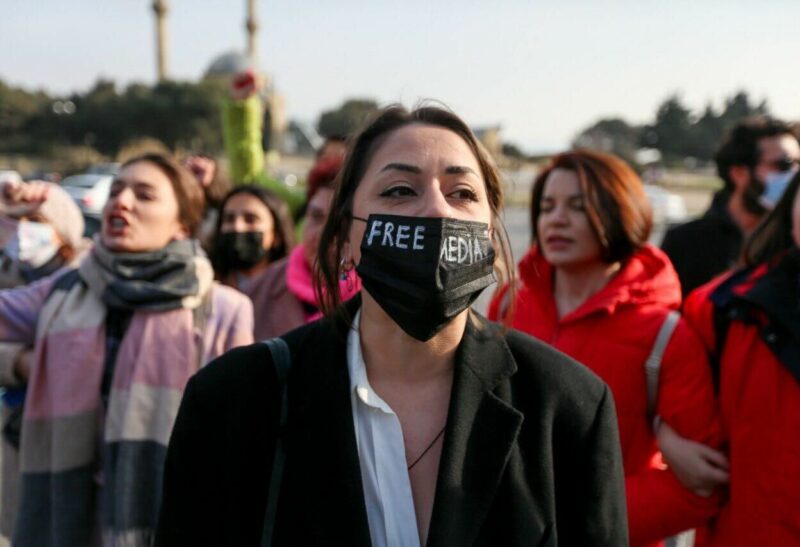After the fall of the USSR, the Caspian Sea was the center of many countries’ interests, and to this day it is a cause of discord connected with dividing up the resources of the Caspian Shelf – oil and gas – and appears as a concentrated tangle of economic and geopolitical interests.
In the 20
th
century, the legal framework for the Caspian was established by the Soviet-Iranian agreements of February 26, 1921 and March 25, 1940, which provided for freedom of marine navigation on the entirety of the water body, fishing freedoms beyond ten-mile national fishing zones and a ban on ships sailing under the flag of a non-Caspian state.
But it did not make provisions for questions regarding the shelf, military activities, through-traffic across the Caspian and the preservation of natural resources. During the time of the USSR, the Caspian Sea was practically an internal water body of the Soviet Union, as a mere 13.8% belonged to Iran, which did not recognize the legitimacy of the sea-border with Azerbaijan along the
Astara-Hasankuli Line
as defined by the above-mentioned agreements, believing that the line was drawn up by the USSR negotiating from a position of strength.
Nevertheless, the Caspian Sea’s status as an intra-continental sea, established by the Soviet-Iranian agreements, was acknowledged by international law.
After the dissolution of the USSR in 1991, the number of Caspian states increased to five: Russia, Iran, Kazakhstan, Azerbaijan and Turkmenistan. There arose the necessity for a new agreement on the status of the Caspian, all the more so because its significance for world energy had grown and the balance of power in the region was subject to the influence of external forces. In Tehran on November 4, 2003, the Caspian nations signed the “
Framework Convention for the Protection of the Marine Environment of the Caspian Sea
”.
The convention entered into force on August 12, 2006.
A key factor is the fact that the Caspian is a closed, intra-continental water body. On the one hand, this is a lake (an endorheic water body), on the other hand it is a sea (because of its large size).
Its length from north to south is about 1200 km, its width from east to west ranges from 195 to 435 km. If the Caspian were to be recognized as a conventional maritime space, it would automatically be covered by the corresponding articles of the UN Conventions on the
Continental Shelf
and
Law of the Sea
(1958 and 1982).
In this case, each of the Caspian states would have sovereign rights to 12-mile territorial waters and 200-mile exclusive economic zones. Since the maximum width of the Caspian Sea doesn’t exceed 200 maritime miles, the outer limits of the exclusive economic zone can be defined on the basis of the
equidistance principle
. In this case, all other states, including those without a point of access to the Caspian such as the USA or UK, have freedom within the exclusive economic zone to engage in maritime navigation and flight, to lay cables and pipelines, to perform scientific research and other forms of activity considered acceptable from the point of view of international law.
In a legal sense, a lake doesn’t have such categories as economic zones, shelfs, and territorial waters. It is considered an internal water body, the sovereign domain of its riparian states, and not subject to international legal framework. The development of a legal framework for a border lake is the sole province of the riparian states themselves, and there exist no legal norms defining even just the general legal questions of the parceling up and exploitation of border lakes. Their legal status can be defined only by all riparian states and is regulated by agreements between them.
This purely legal question destabilizes the already-complex situation on the Caspian. If we take just the conflict between Turkmenistan and Azerbaijan over three oil fields on the Caspian: the Kyapaz oil field (Turkmen name – Serdar), which is closer to the Turkmen than the Azerbaijani shore, and to a lesser degree the Azeri and Chirag oil fields (in Turkmen, Osman and Omar), which are located roughly in the center of the Caspian. Turkmenistan considers these oilfields its own, but Azerbaijan makes reference to the Soviet period when they were developed by Azerbaijani oil workers.
The central question is regarding the principal for dividing the sea floor. Azerbaijan, Kazakhstan and Turkmenistan insist on dividing the Caspian along a center line, Iran on division by fifths (20%) between each of the Caspian states. Moreover, Iran is categorically opposed to the conclusion of some sort of bilateral agreement, since, according to those already concluded between Russia and Azerbaijan, Russia and Kazakhstan, and also Azerbaijan and Kazakhstan, in the division of the sea floor Russia would receive 19%, Azerbaijan – 18%, and Kazakhstan – 27%. These states would receive 64% of the sea floor. Of the remaining 36%, Iran would receive up to 14%. In Tehran, there is regret that attention wasn’t paid to this in time, regarding such a situation as damaging for Iran. But Russia is Iran’s partner, if only in exploitation of the Bushehr Nuclear Power Plant. This is why Tehran takes a moderate tone in the fight over the division of the sea floor. Although on the whole Iran continues to demand an increase in its share in the division of the Caspian Sea shelf.
Russia, Kazakhstan and Azerbaijan hold to the principle of dividing up the floor along a center line, drawn taking into account the equidistance of geographic points, and leaving the sea surface for general use, i.e. they are for demarcation of mineral resources and the Caspian Sea shelf, but against dividing up its waters. Russia acknowledges that the Soviet-Iranian agreements need to be updated taking into account modern realities, but proposes acting in accordance with the old agreements up until the completion of negotiations. As such, the only framework in effect on the Caspian is in which the Caspian is open to universal use for all riparian states and closed off for all non-riparian states.
Azerbaijan’s efforts are directed towards dividing up the sea floor, i.e. oil and gas. Wanting to receive the most gas- and oil-rich regions of the Caspian, Azerbaijan has put into practice the concept of the “national sector of the Caspian Sea of a particular country”. Baku asserts that Caspian affairs cannot continue to be guided by the Soviet-Iranian agreements, since they do not address the question of developing the sea floor. Azerbaijan proposes defining the national sectors of the Caspian by extending land borders to the center line, equidistant from the shore; in the case that islands are present, from the conventional border that unites the shores of these islands oriented towards the center line; and between neighboring states according to a conventional border which is a natural extension of the land borders, perpendicular to the center line of the water body. In this case, the borders of corresponding sectors will become state borders, with the sovereignty implied by this over all forms of activity within a given sector. It’s true that the status of ‘lake’ doesn’t exclude the division of the Caspian into national sectors, but is also doesn’t oblige this. Before November, 1996, Moscow, Ashgabat and Tehran fully refused the possibility of nationalization of bits of the sea in its central part. However, with time, they have changed their positions: nobody benefits from a confrontation with Baku and Astana, not even Russia, which has signed not just a few agreements on transit of oil from the Azerbaijani and Kazakh sectors.
And while the jury is still out, the Caspian states have taken to unilaterally dividing up the Caspian into national sectors. So, Azerbaijan included the Azari, Kyapaz and Chirag oil fields in its legally-nonexistent sector, and Kazakhstan and Russian are fighting over several oil fields in the North Caspian.
And back in 2006, the Iranian North Drilling Company and Hong Kong-registered China Oilfield Services Ltd concluded a three-year contract for oil reserve exploration in the Iranian sector. Iran doesn’t have experience in drilling wells at a depth of more than 90 meters, whereas the maximum depth of the Caspian Sea in its sector is 1,025 meters. Because of this, the Chinese helped them to build a floating installation capable of drilling at a maximum depth of up to 6,000 meters for a cost of $250 million.
In this way fossil fuel reserves have transformed the Caspian into a zone of clashing geopolitical interests of various countries. However, one, no less important problem remains unnoticed behind these interests. The biological uniqueness of the Caspian Sea consists of the fact that it contains a world gene pool of beluga, starry, and other forms of sturgeon, and is the sole store of species variety of these fish in the world – around 90% of the world reserves. The natural resources of the sea include over 854 species, of which 30 have commercial value. In this closed water body, in conditions of reduced salinity, over the course of about 1.8 million years, the fauna evolved separately from the world ocean, creating a great number of species of relict fish, and this process is still not over. Not long ago, the catch of sturgeon in the Caspian was over 80% of the world total. Now they have ceased to be the Caspian’s prime resource. Over the past 15-20 years, the number of Caspian sturgeon have achieved a level dangerous for their replenishment as a resource. And this is because of the absence of a united approach to exploitation of bio-resources, as was the case during the USSR period, and interest only in fossil fuel extraction, and so ecological problems have taken a back seat, because everyone’s primary goal is to receive maximum profit. The Caspian states are developing countries and too poor to spend money on the environment. Their position regarding the Caspian is first economy, then ecology. Exploitation of the Caspian’s resources is taking place within a framework of separate sectors, without some sort of harmonization of economic activities with the sea’s ecology. There is no common strategy for resource development, no united policy for preserving the environment, ecological monitoring, fines and warnings for technical accidents. Bilateral agreements are insufficient for this and cannot resolve the ecological problems in conditions where the legal status of the Caspian is undefined.
It’s clear that sooner or later the Caspian states will have to come to an agreement. In the case of coordinated action they can jointly extract maximum benefits. But if these countries decide to engage in unilateral politics, then a significant part of the potential benefits might be received by those who are not among the Caspian players, and the resources and ecology of the Caspian might be irreparably damaged.



